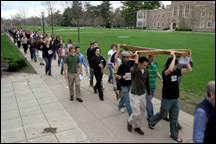
Waxing skeptical for an easily shocked audience, the media mogul Ted Turner once pluckily described Christianity asa religion for losers.His cracker-barrel taunt was unintentionally profound and is particularly resonant during the Lenten season, when the very promise of our redemption and our reckoning of its cost make our plight so conspicuously pathetic.
Christianity is all about loserslosing life to gain it, losing selves to find them, learning to await a losers rescue.The hero of the Christian insurgency is betrayed, arrested, jailed, judged, humiliated, tortured, defeated, run out of town, strung up and nailed naked to a tree, dead as road kill, with derisive graffiti scrawled above his absurdly crowned head.They even bury him in another mans grave, almost as an afterthought, this Loser of the Year, of the Millennium, of All Time.King of the Losers.Our King, whose grotesquely stretched corpse adorns our churches, bedroom walls, and the pendants sometimes hanging from our necks.
The Stations of the Cross are devotional exercises designed to emphasize this unsettling reality.Their roots are in ancient pilgrimages to the Holy Land made by devout travelers aspiring to a virtual following in the footsteps of their condemned Lord.By the Middle Ages, it had become a custom among those many European faithful who couldnt afford or withstand such pilgrimages to erect a series of shrines which gradually became standardized into 14stations,each associated with an event in Christs passion and death, beginning with the condemnation of Jesus and ending with his burial. One famous series of Stations is in the Coliseum in Rome, where the Pope leads a torchlight procession on Good Friday.
During the last five centuries, these tableaux of atrocity and failure have become artistic conventions, liturgical fixtures, and icons of imaginative prayer.They recently headlined Hollywood news as controversy roiled around the excitable Mel Gibson and the popular film he made about them.
Each Lenten Friday evening (at 7:15 p.m.) the 7-foot-tall Stations which flank its east and west walls are followed by worshipers through Notre Dames Basilica of the Sacred Heart.The Roman artist Luigi Gregori, whose Columbus murals also decorate the Universitys Main Building, began painting them in 1874 under a three-year contract.Gregori, who remained at Notre Dame for 17 years as artist-in-residence, used members of his family, Notre Dames founder (and his employer) Rev. Edward Sorin, C.S.C., and many other contemporary Holy Cross priests, brothers, and laypeople as models for the figures in each.Such local connections are not unique to Gregoris depictions of Christs passion. As Peter Steinfels recently observed in a New York Times article,the Stations are like much Christian art (and like much other religious art, one could add): no matter how brief and straightforward the original source, the believer, the preacher, the artist inevitably flesh it out, adding detail and new perspectives to help each devotee enter personally into the story and identify with the holy.
This intention becomes palpable at Notre Dame on Tuesday of Holy Week, when improvised Stations traverse the Notre Dame campus and students, alumni, faculty, staff and friends of the University take part in a campus-wide, candlelight procession beginning at the Grotto of Our Lady of Lourdes and stopping at various sites before finishing in the Basilica of the Sacred Heart for veneration of the cross and a celebration of the Sacrament of Reconciliation.
As seems appropriate for this homely pilgrimage to an omnipresent Holy Land, the 14 Stations are always nearby on the Notre Dame campus, presented in a wide variety of settings, and to a wide variety of sensibilities.In a park beside the Fatima Retreat Center a colorful series of glass-encased mosaics of the Stations is available to campus visitors and residents as well as to anyone driving down U.S. 933; the Stations which encircle the campus worship spaces include a celebrated series in Malloy Halls Mary Seatof Wisdom Chapel by Notre Dame artist Rev. James F. Flanigan, C.S.C.; and the etchings of the Stations in the Basilicas crypt chapel, which, like the Stations in the old Log Chapel, are inscribed with French captions, are widely believed to have been brought here by Father Sorin in Notre Dames earliest days.No matter the quality nor the provenance, these images seem always more absorbing and far more challenging than ordinary artworks.
Some 80 years ago Mr. and Mrs. Frank J. Carroll of Chicago donated a series of cast bronze Stations to Notre Dame in memory of their parents.Perhaps the most heavily trafficked of these parochial pilgrim trails, it begins with Christ before Pilate (in a thicket behind Columba Hall) and traces his shaming along the St. Joseph Lake jogging trail and ends with his crucifixion and entombment in the sycamore grove above.
Paradoxically uphill flows this graphic narrative of dread, pain, sorrow, and loss, rising through a fine and indifferent landscapea litany of reassurance that the most ordinary and overlooked anguish is significant even to God, a suggestion that there is indeed a true homeland, one finer even than this splendid lakeshore, and that all this tedium, all this futility, this whole losers lifeif it only be borne in Lovewill become bearable, will become, in fact, an undeserved gift, a joy too astonishing for the hearts of mere men and mere women, a joy too fierce for this mere world.
TopicID: 26926